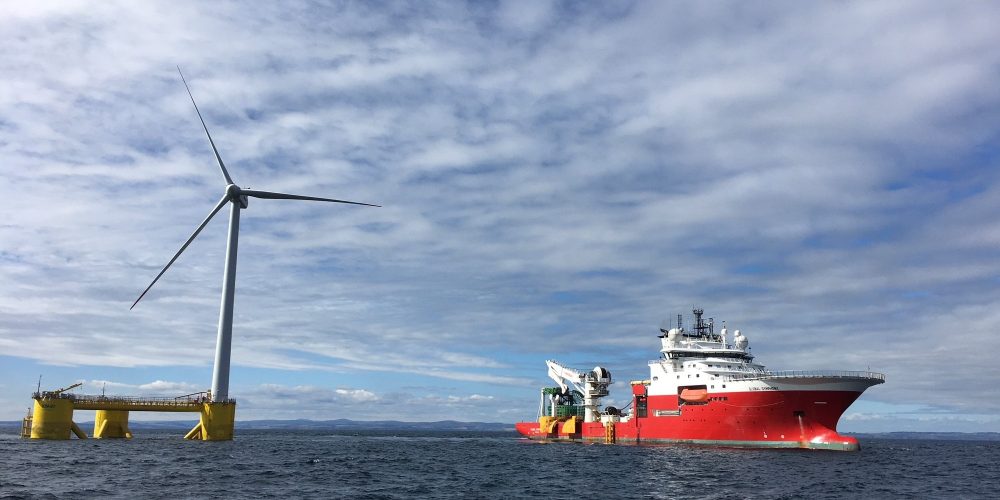In today’s Electrek Green Energy Brief (EGEB):
- The final floating turbine is connected at the Kincardine floating offshore wind farm in Scotland.
- 2021’s most and least energy-expensive states, according to a new WalletHub study.
- UnderstandSolar is a free service that links you to top-rated solar installers in your region for personalized solar estimates. Tesla now offers price matching, so it’s important to shop for the best quotes. Click here to learn more and get your quotes. — *ad.
Floating wind farm in Scotland
The fifth and final floating wind turbine is now connected to its moorings at the Kincardine wind farm off the coast of Aberdeen, Scotland.
Connector technology company First Subsea said the last Vestas V174 9.5 megawatt (MW) wind turbine was connected this past weekend. First Subsea will help with the connection of the cable protection system for the dynamic cables later this summer.
Once it’s live, the 50 MW Kincardine project, which was developed by the Madrid-headquartered Cobra Group, will be the world’s largest floating offshore wind farm, with six turbines about nine miles (14 km) off the coast. It consists of a 2 MW Vestas turbine, which has been operating since October 2018, and five 9.5 MW Vestas turbines. Kincardine will generate up to 218 GWh of power annually, which will be enough to power around 55,000 households in Scotland.

Read more: Biden administration opens up the US Pacific coast to offshore wind
Most and least energy-expensive states
With residential electricity use projected to increase by 2.8% in 2021, the personal-finance website WalletHub today released its report, “2021’s Most & Least Energy-Expensive States.”
WalletHub compared the average monthly energy bills in each of the 50 states and the District of Columbia using a special formula that accounts for the following residential energy types: electricity, natural gas, motor fuel, and home heating oil. (In other words, those are all fossil fuels with rising costs.)
The dollar amount listed beside each state above reflects its average monthly energy bill:
| Most energy-expensive states | Least energy-expensive states | |
| 1. Connecticut ($411) | 42. Nebraska ($303) | |
| 2. Wyoming ($403) | 43. Iowa ($301) | |
| 3. Massachusetts ($380) | 44. Louisiana ($301) | |
| 4. Georgia ($374) | 45. Illinois ($300) | |
| 5. Alabama ($371) | 46. Idaho ($298) | |
| 6. Maine ($370) | 47. Arizona ($295) | |
| 7. Alaska ($366) | 48. Oregon ($275) | |
| 8. Mississippi ($358) | 49. Colorado ($269) | |
| 9. Indiana ($356) | 50. Washington ($262) | |
| 10. New Hampshire ($355) | 51. District of Columbia ($217) |
Hawaii has the lowest average monthly consumption of electricity per consumer, 501 kWh, which is three times lower than in Louisiana, the highest at 1,484 kWh.
Washington has the lowest average retail price for electricity, $0.0971 per kWh, which is 3.3 times lower than in Hawaii, the highest at $0.3206 per kWh.
New Mexico has the lowest average residential price for natural gas, $6.40 per 1,000 cubic feet, which is 6.9 times lower than in Hawaii, the highest at $44.14 per 1,000 cubic feet.
In Northeastern states, between 8% and 62% of households use heating oil to heat their homes, compared with less than 3% of households in the rest of the US.
The District of Columbia has the lowest average monthly motor-fuel consumption per driver, 23.46 gallons, which is 3.4 times lower than in Wyoming, the highest at 80.53 gallons.
(Wyoming, despite producing all that oil, you might want to consider going electric.)
You can see how your state ranks here.
Main Photo: Cobra Group
Subscribe to Electrek on YouTube for exclusive videos and subscribe to the podcast.

Your perspective on this topic is very interesting. Thanks for the detailed explanation.
order lasuna sale – purchase himcolin online order himcolin generic
besivance online order – besivance ca purchase sildamax generic
neurontin usa – gabapentin where to buy sulfasalazine usa
benemid 500 mg cheap – buy cheap generic carbamazepine order carbamazepine 200mg online cheap
celebrex 200mg tablet – flavoxate where to buy order indomethacin capsule
colospa 135mg cheap – order cilostazol 100 mg generic buy pletal pills
buy diclofenac 100mg pills – order cambia sale buy generic aspirin online
rumalaya for sale – purchase shallaki pills buy elavil without a prescription
mestinon 60mg cheap – buy generic azathioprine buy azathioprine pills for sale
diclofenac online – imdur 20mg canada nimodipine price
cheap ozobax – buy ozobax tablets order feldene 20 mg
meloxicam 7.5mg ca – toradol 10mg pills ketorolac brand
periactin 4mg uk – cyproheptadine 4 mg us tizanidine online order
buy trihexyphenidyl tablets – purchase diclofenac gel for sale buy diclofenac gel online cheap
brand cefdinir – omnicef drug clindamycin ca
buy isotretinoin 40mg online – deltasone 20mg drug buy deltasone sale
oral prednisone 40mg – zovirax cost permethrin over the counter
permethrin order – retin gel ca retin online
betamethasone 20gm sale – order differin online benoquin for sale online
oral flagyl 200mg – order metronidazole online cheap order cenforce 50mg online cheap
order generic augmentin – levothroid online order cheap levothroid generic
buy cleocin 300mg generic – order indomethacin 75mg without prescription buy indomethacin 75mg for sale
buy hyzaar pill – order generic cephalexin 125mg cephalexin 500mg pills
order generic eurax – buy generic mupirocin online aczone over the counter
provigil 200mg drug – buy phenergan pills for sale where can i buy meloset
buy zyban 150mg online – orlistat 60mg pill shuddha guggulu brand
buy capecitabine 500 mg online – buy capecitabine generic order danocrine 100mg online
progesterone 100mg pill – oral ponstel clomiphene generic
order alendronate 35mg pills – order alendronate 35mg sale purchase medroxyprogesterone pills
cabergoline generic – buy cabgolin tablets alesse order online
estrace 2mg cost – order letrozole pill buy generic anastrozole online